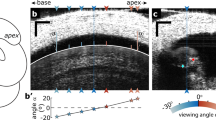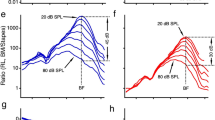Abstract
Hearing depends on the transformation of sound-induced basilar membrane vibration into deflection of stereocilia1 on the sensory hair cells, but the nature of these mechanical transformations is unclear. Using new techniques to visualize and measure sound-induced vibration deep inside the moving organ of Corti, we found that two functionally crucial structures, the basilar membrane and the reticular lamina, have different centers of rotation, leading to shearing motion and rapid deformation for the mechanoreceptive outer hair cells. Structural relations within the organ of Corti are much more dynamic than previously thought, which clarifies how outer hair cell molecular motors can have such a powerful effect.
This is a preview of subscription content, access via your institution
Access options
Subscribe to this journal
Receive 12 print issues and online access
$209.00 per year
only $17.42 per issue
Buy this article
- Purchase on Springer Link
- Instant access to full article PDF
Prices may be subject to local taxes which are calculated during checkout


Similar content being viewed by others
References
Hudspeth, A.J. Nature 341, 397–404 (1989).
Zheng, J. et al. Nature 405, 149–155 (2000).
Liberman, M.C. et al. Nature 419, 300–304 (2002).
ter Kuile, E. Pflügers Arch. 79, 146–157 (1900).
Hemmert, W., Zenner, H.-P. & Gummer, A.W. Biophys. J. 78, 2285–2297 (2000).
Hu, X., Evans, B.N. & Dallos, P. J. Neurophysiol. 82, 2798–2807 (1999).
Mammano, F. & Ashmore, J.F. Nature 365, 838–841 (1993).
Nilsen, K.E. & Russell, I.J. Nat. Neurosci. 2, 642–648 (1999).
Nuttall, A.L., Guo, M. & Ren, T. Hearing Res. 131, 39–46 (1999).
Fridberger, A., Boutet de Monvel, J. & Ulfendahl, M. J. Neurosci. 22, 9850–9857 (2002).
Ulfendahl, M., Khanna, S.M., Fridberger, A., Flock, Å. & Jäger, W. J. Neurophysiol. 76, 3850–3862 (1996).
Horn, B.K.P. & Schunck, B.G. Artif. Intell. 17, 185–203 (1981).
Frolenkov, G.I., Mammano, F. & Kachar, B. J. Physiol. 531, 667–676 (2001).
Brundin, L., Flock, Å. & Canlon, B. Nature 342, 814–816 (1989).
Rybalchenko, V. & Santos-Sacchi, J. J. Physiol. (in press).
Acknowledgements
J. Bruton, J. Lännergren, M. Ulfendahl, T. Ren, L. Järlebark, A. Katz and Å. Flock are acknowledged for discussions and gift of equipment. Supported by the Swedish Research Council, the Tysta Skolan Foundation, the National Association for Hard of Hearing People, Tore Nilson Foundation, the Royal Swedish Academy of Sciences, Swedish Society for Medical Research, Swedish Medical Society and funds of the Karolinska Institute.
Author information
Authors and Affiliations
Corresponding author
Ethics declarations
Competing interests
The authors declare no competing financial interests.
Supplementary information
Supplementary Video.
Sound-evoked motion within the hearing organ.Images were obtained at two different phases of the sound stimulus (126 dB SPL,160 Hz) and assembled into this movie. (MOV 978 kb)
Supplementary Fig. 1.
Displacement as a function of distance along the reticular lamina (a) and along the basilar membrane (b) in five different image pairs.The solid lines are regression lines through all the data points. Stimulus parameters:160 Hz,123 dB SPL. (PDF 47 kb)
Rights and permissions
About this article
Cite this article
Fridberger, A., de Monvel, J. Sound-induced differential motion within the hearing organ. Nat Neurosci 6, 446–448 (2003). https://doi.org/10.1038/nn1047
Received:
Accepted:
Published:
Issue Date:
DOI: https://doi.org/10.1038/nn1047
This article is cited by
-
The sensitivity of mechanoelectrical transduction response phase to acoustic overstimulation is calcium-dependent
Pflügers Archiv - European Journal of Physiology (2024)
-
Inner hair cell stereocilia are embedded in the tectorial membrane
Nature Communications (2021)
-
In situ motions of individual inner-hair-cell stereocilia from stapes stimulation in adult mice
Communications Biology (2021)
-
Basilar Membrane and Tectorial Membrane Stiffness in the CBA/CaJ Mouse
Journal of the Association for Research in Otolaryngology (2014)
-
Sound-induced length changes in outer hair cell stereocilia
Nature Communications (2012)



